I’m a believer in good nonfiction. Done right, nonfiction can be as compelling as novels, and it teaches us about our world in a more direct way. In observance of Women’s History Month, I’ve prepared a list of six exciting and educational books about real women, in chronological order:
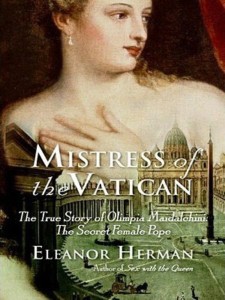 Mistress of the Vatican by Eleanor Herman (2009, 452 pages): This rollicking good time in seventeenth century Italy tells of Olimpia Maidalchini, a woman truly ahead of her time. Her lifetime of transgressive power began when, as a young teen, she defied her father’s attempt to force her into a convent so he could save the money he would have spent on her dowry to pass on to his son and heir. Instead, she married the richest man in town and then, when widowed at twenty, married again. It was this second marriage that allowed her control of issues on the world stage, for her new brother-in-law was the future Pope Innocent X. Olimpia and her brother-in-law were very close, and his indecisive nature rendered her the de facto Pope and power behind the throne. During his decade-long tenure, she appointed cardinals, negotiated treaties, and enriched herself and her family in the Pope’s name. Historian Eleanor Herman has written extensively on royal mistresses, poison, and murder, and always delivers an impeccably-researched but well-told and entertaining book.
Mistress of the Vatican by Eleanor Herman (2009, 452 pages): This rollicking good time in seventeenth century Italy tells of Olimpia Maidalchini, a woman truly ahead of her time. Her lifetime of transgressive power began when, as a young teen, she defied her father’s attempt to force her into a convent so he could save the money he would have spent on her dowry to pass on to his son and heir. Instead, she married the richest man in town and then, when widowed at twenty, married again. It was this second marriage that allowed her control of issues on the world stage, for her new brother-in-law was the future Pope Innocent X. Olimpia and her brother-in-law were very close, and his indecisive nature rendered her the de facto Pope and power behind the throne. During his decade-long tenure, she appointed cardinals, negotiated treaties, and enriched herself and her family in the Pope’s name. Historian Eleanor Herman has written extensively on royal mistresses, poison, and murder, and always delivers an impeccably-researched but well-told and entertaining book.
Bringing Down the Colonel by Patricia Miller (2018, 368 pages): In a tale for the #MeToo era, Patricia Miller relates the facts concerning a pivotal lawsuit of the Gilded Age. 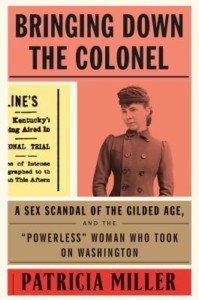 Madeline Pollard was only a teenager when the much-older Kentucky Congressman William Breckinridge began an affair with her. Ten years later, when his wife died, he told Pollard he would marry her. Instead, he married someone else. In a time when premarital and extramarital sex for women was ruinous, Pollard filed for breach of contract– an uncommon legal provision that allowed recompense for women whose prospects had been damaged by a broken attachment. Breckinridge, a moral crusader who had spoken publicly on the importance of chastity for women, was brought to task for his own immoral behavior over the course of the sensational five-week trial. Pollard asked for equal treatment under law and society for sexual behavior across gender lines, remarkable for her era. Even more remarkable? She won.
Madeline Pollard was only a teenager when the much-older Kentucky Congressman William Breckinridge began an affair with her. Ten years later, when his wife died, he told Pollard he would marry her. Instead, he married someone else. In a time when premarital and extramarital sex for women was ruinous, Pollard filed for breach of contract– an uncommon legal provision that allowed recompense for women whose prospects had been damaged by a broken attachment. Breckinridge, a moral crusader who had spoken publicly on the importance of chastity for women, was brought to task for his own immoral behavior over the course of the sensational five-week trial. Pollard asked for equal treatment under law and society for sexual behavior across gender lines, remarkable for her era. Even more remarkable? She won.
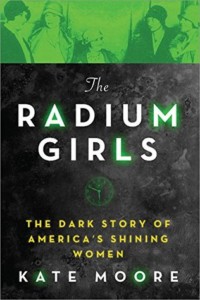 The Radium Girls by Kate Moore (2017, 479 pages): Also available as an audio CD, an ebook on Overdrive, and on hoopla as both ebook and audiobook, this book chronicles the fates of workers at factories painting watch dials between 1914 and the late 1920s. Radioactive material was used to make glowing numbers appear on watch faces, and the workers– largely young women to whom many other lucrative forms of employment were closed– were instructed to use their lips to twist their paintbrushes to the desired fine point. Little did they know, exposure to radium would cause them to develop severe long-term health problems like anemia, infertility, bone fractures, necrosis of the jaw, and cancer. Driven into debt by their ill health and slandered after their deaths as victims of syphilis, the women banded together to sue their employers for failing to protect them from the known dangers of radium poisoning. The lawsuit and the publicity surrounding it resulted in the establishment of occupational labor law and greatly advanced both health physics and labor rights. Because of radium’s 1,600 year half-life, their bodies are still radioactive today.
The Radium Girls by Kate Moore (2017, 479 pages): Also available as an audio CD, an ebook on Overdrive, and on hoopla as both ebook and audiobook, this book chronicles the fates of workers at factories painting watch dials between 1914 and the late 1920s. Radioactive material was used to make glowing numbers appear on watch faces, and the workers– largely young women to whom many other lucrative forms of employment were closed– were instructed to use their lips to twist their paintbrushes to the desired fine point. Little did they know, exposure to radium would cause them to develop severe long-term health problems like anemia, infertility, bone fractures, necrosis of the jaw, and cancer. Driven into debt by their ill health and slandered after their deaths as victims of syphilis, the women banded together to sue their employers for failing to protect them from the known dangers of radium poisoning. The lawsuit and the publicity surrounding it resulted in the establishment of occupational labor law and greatly advanced both health physics and labor rights. Because of radium’s 1,600 year half-life, their bodies are still radioactive today.
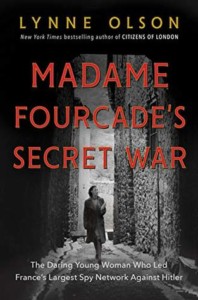
Madame Fourcade’s Secret War by Lynne Olson (2019, 464 pages): During World War II, a brave and glamorous Frenchwoman named Marie-Madeleine Fourcade formed a Resistance spy network called the Alliance, using the codename Hedgehog. Twice imprisoned by Nazis, she escaped and persisted, living on the run. She won the respect of even very traditional men, sustaining the longest-lived and most effective spy network of the French Resistance. Her efforts were instrumental in the success of D-Day, and her war no longer needs to be a secret. Drawing on interviews with surviving members of the Alliance and their families, Lynne Olson has delivered a tense and riveting look at an extraordinary woman who refused to sit by while human rights were violated and her country was under siege.
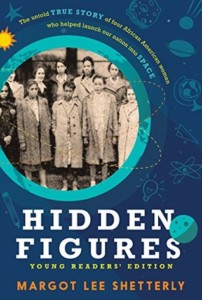 Hidden Figures by Margot Lee Shetterly (2016, 346 pages): Also available on hoopla as an audiobook and a revised audiobook for young listeners, on Overdrive as an ebook, and of course the film adaptation in both DVD and Blu-ray formats, this New York times #1 bestseller is one you don’t want to miss. Dorothy Vaughan, Mary Jackson, Katherine Johnson, and Christine Darden were four African-American math teachers who stepped into aeronautical work during the labor shortages of World War II. Shetterly’s book follows their careers over three decades as their contributions to the field of aeronautical engineering grew, despite the Jim Crow laws of Virginia that mandated they work separately from their white colleagues. Their accomplishments made launching rockets and astronauts into space possible. NASA’s greatest successes during the Cold War were owed to these “human computers” who worked using pencils, slide rules, and their own brains.
Hidden Figures by Margot Lee Shetterly (2016, 346 pages): Also available on hoopla as an audiobook and a revised audiobook for young listeners, on Overdrive as an ebook, and of course the film adaptation in both DVD and Blu-ray formats, this New York times #1 bestseller is one you don’t want to miss. Dorothy Vaughan, Mary Jackson, Katherine Johnson, and Christine Darden were four African-American math teachers who stepped into aeronautical work during the labor shortages of World War II. Shetterly’s book follows their careers over three decades as their contributions to the field of aeronautical engineering grew, despite the Jim Crow laws of Virginia that mandated they work separately from their white colleagues. Their accomplishments made launching rockets and astronauts into space possible. NASA’s greatest successes during the Cold War were owed to these “human computers” who worked using pencils, slide rules, and their own brains.
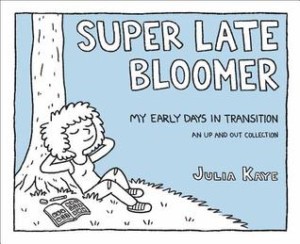
Super Late Bloomer by Julia Kaye (2018, 158 pages): Also available as an ebook on hoopla, this book is a collection of Julia Kaye’s popular online comic series Up and Out, specifically her autobiographical comics about her gender transition. Kaye has always turned to art rather than traditional journaling to express herself, and this comic represents five months of her picture diary in the early stages of her transition. Heartfelt and affecting, this account will show you the joys and challenges of her experience in an easily-enjoyed form.
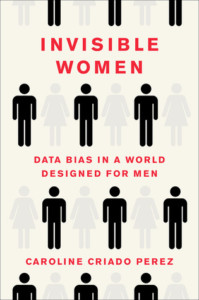 Invisible Women by Caroline Criado-Perez (2019, 411 pages): History and personal narratives not your jam? Subtitled “data bias in a world designed for men,” this book is a fantastic alternative for those more interested in the numbers of right now. Caroline Criado-Perez investigates how seat belts, medical research, office temperatures, and even cell phone designs are calculated and measured according to measurements of the average man– not the average woman– and how this inequity plays out in the world. For example, women involved in car accidents are 47% more likely to be seriously injured or killed than men involved in the same accidents. An excerpt shared on bustle.com earlier this month reveals that the size of piano keyboards and smartphones disadvantage women and leave them more prone to injury simply because their hands are smaller than the product is designed for. Fascinating and incredibly data-heavy, this book is full of startling information about the world we live in.
Invisible Women by Caroline Criado-Perez (2019, 411 pages): History and personal narratives not your jam? Subtitled “data bias in a world designed for men,” this book is a fantastic alternative for those more interested in the numbers of right now. Caroline Criado-Perez investigates how seat belts, medical research, office temperatures, and even cell phone designs are calculated and measured according to measurements of the average man– not the average woman– and how this inequity plays out in the world. For example, women involved in car accidents are 47% more likely to be seriously injured or killed than men involved in the same accidents. An excerpt shared on bustle.com earlier this month reveals that the size of piano keyboards and smartphones disadvantage women and leave them more prone to injury simply because their hands are smaller than the product is designed for. Fascinating and incredibly data-heavy, this book is full of startling information about the world we live in.
